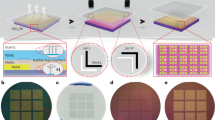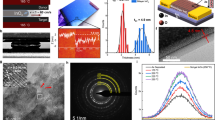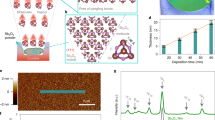Abstract
Two-dimensional materials made via solution processing could be used to create next-generation electronic devices at scale. However, existing solution processing methods typically have a trade-off between scalability and material quality, which makes them unsuitable for practical applications. Here we show that wafer-scale arrays of molybdenum-disulfide-based transistors can be fabricated using a commercial slot-die printing process. We create inks of molybdenum disulfide nanosheets and sodium-embedded alumina for printing of the semiconductor and gate dielectric layer, respectively. The transistors exhibit average charge carrier mobilities of 80.0 cm2 V−1 s−1 in field-effect transistor measurements and 132.9 cm2 V−1 s−1 in Hall measurements at room temperature. The high charge carrier mobility is attributed to the sodium-embedded alumina gate dielectric, which causes a band-like charge carrier transport in the molybdenum-disulfide-nanosheet-based thin-film networks. We use the transistors to create various logic gates, including NOT, NOR, NAND and static random-access memory.
This is a preview of subscription content, access via your institution
Access options
Access Nature and 54 other Nature Portfolio journals
Get Nature+, our best-value online-access subscription
$29.99 / 30 days
cancel any time
Subscribe to this journal
Receive 12 digital issues and online access to articles
$119.00 per year
only $9.92 per issue
Buy this article
- Purchase on Springer Link
- Instant access to full article PDF
Prices may be subject to local taxes which are calculated during checkout



Similar content being viewed by others
Data availability
Source data are provided with this paper. The other data that support the findings of this study are available from the corresponding authors upon reasonable request.
References
McDonald, S. A. et al. Solution-processed PbS quantum dot infrared photodetectors and photovoltaics. Nat. Mater. 4, 138–142 (2005).
de Arquer, F. P. G., Armin, A., Meredith, P. & Sargent, E. H. Solution-processed semiconductors for next-generation photodetectors. Nat. Rev. Mater. 2, 16100 (2017).
Han, S. J. et al. High-speed logic integrated circuits with solution-processed self-assembled carbon nanotubes. Nat. Nanotechnol. 12, 861–865 (2017).
Kelly, A. G. et al. All-printed thin-film transistors from networks of liquid-exfoliated nanosheets. Science 356, 69–72 (2017).
Hu, G. H. et al. Functional inks and printing of two-dimensional materials. Chem. Soc. Rev. 47, 3265–3300 (2018).
Lin, Z. Y. et al. Solution-processable 2D semiconductors for high-performance large-area electronics. Nature 562, 254–258 (2018).
Kagan, C. R., Lifshitz, E., Sargent, E. H. & Talapin, D. V. Building devices from colloidal quantum dots. Science 353, aac5523 (2016).
Geier, M. L. et al. Solution-processed carbon nanotube thin-film complementary static random access memory. Nat. Nanotechnol. 10, 944–948 (2015).
Kang, J., Sangwan, V. K., Wood, J. D. & Hersam, M. C. Solution-based processing of monodisperse two-dimensional nanomaterials. Acc. Chem. Res. 50, 943–951 (2017).
Coleman, J. N. et al. Two-dimensional nanosheets produced by liquid exfoliation of layered materials. Science 331, 568–571 (2011).
Kim, J. et al. All-solution-processed van der Waals heterostructures for wafer-scale electronics. Adv. Mater. 34, 2106110 (2022).
Zhu, J. & Hersam, M. C. Assembly and electronic applications of colloidal nanomaterials. Adv. Mater. 29, 1603895 (2017).
Piatti, E. et al. Charge transport mechanisms in inkjet-printed thin-film transistors based on two-dimensional materials. Nat. Electron. 4, 893–905 (2021).
Lin, Z. Y., Huang, Y. & Duan, X. F. Van der Waals thin-film electronics. Nat. Electron. 2, 378–388 (2019).
Zhang, X., Lai, Z. C., Tan, C. L. & Zhang, H. Solution-processed two-dimensional MoS2 nanosheets: preparation, hybridization, and applications. Angew. Chem. Int. Ed. 55, 8816–8838 (2016).
Kim, J. et al. Solution-processed MoS2 film with functional interfaces via precursor-assisted chemical welding. ACS Appl. Mater. Interfaces 13, 12221–12229 (2021).
Fivaz, R. & Mooser, E. Mobility of charge carriers in semiconducting layer structures. Phys. Rev. 163, 743 (1967).
McDonnell, S. et al. HfO2 on MoS2 by atomic layer deposition: adsorption mechanisms and thickness scalability. ACS Nano 7, 10354–10361 (2013).
Fallahazad, B. et al. Scaling of Al2O3 dielectric for graphene field-effect transistors. Appl. Phys. Lett. 100, 093112 (2012).
Radisavljevic, B., Radenovic, A., Brivio, J., Giacometti, V. & Kis, A. Single-layer MoS2 transistors. Nat. Nanotechnol. 6, 147–150 (2011).
Johnson, R. W., Hultqvist, A. & Bent, S. F. A brief review of atomic layer deposition: from fundamentals to applications. Mater. Today 17, 236–246 (2014).
Cho, J. H. et al. Printable ion-gel gate dielectrics for low-voltage polymer thin-film transistors on plastic. Nat. Mater. 7, 900–906 (2008).
Kim, B. J. et al. Water-gel for gating graphene transistors. Nano Lett. 14, 2610–2616 (2014).
Herlogsson, L. et al. Low-voltage polymer field-effect transistors gated via a proton conductor. Adv. Mater. 19, 97–101 (2007).
Larsson, O., Said, E., Berggren, M. & Crispin, X. Insulator polarization mechanisms in polyelectrolyte-gated organic field-rffect transistors. Adv. Funct. Mater. 19, 3334–3341 (2009).
Liu, Y., Guan, P. F., Zhang, B., Falk, M. L. & Katz, H. E. Ion dependence of gate dielectric behavior of alkali metal ion-incorporated aluminas in oxide field-effect transistors. Chem. Mater. 25, 3788–3796 (2013).
Zhang, B., Liu, Y., Agarwala, S., Yeh, M. & Katz, H. E. Structure, sodium ion role, and practical issues for β-alumina as a high-k solution-processed gate layer for transparent and low-voltage electronics. ACS Appl. Mater. Interfaces 6, 6991 (2014).
Pal, B. N., Dhar, B. M., See, K. C. & Katz, H. E. Solution-deposited sodium beta-alumina gate dielectrics for low-voltage and transparent field-effect transistors. Nat. Mater. 8, 898–903 (2009).
Amani, M. et al. Near-unity photoluminescence quantum yield in MoS2. Science 350, 1065–1068 (2015).
Lin, P., Zhu, L. P., Li, D. & Wang, Z. L. Defect repair for enhanced piezo-phototronic MoS2 flexible phototransistors. J. Mater. Chem. C 7, 14731–14738 (2019).
Ippolito, S. et al. Covalently interconnected transition metal dichalcogenide networks via defect engineering for high-performance electronic devices. Nat. Nanotechnol. 16, 592–598 (2021).
Sakanoue, T. & Sirringhaus, H. Band-like temperature dependence of mobility in a solution-processed organic semiconductor. Nat. Mater. 9, 736–740 (2010).
Wang, S. et al. Band-like transport in surface-functionalized highly solution-processable graphene nanosheets. Adv. Mater. 20, 3440–3446 (2008).
Jariwala, D. et al. Band-like transport in high mobility unencapsulated single-layer MoS2 transistors. Appl. Phys. Lett. 102, 173107 (2013).
Qiu, H. et al. Hopping transport through defect-induced localized states in molybdenum disulphide. Nat. Commun. 4, 2642 (2013).
Xue, J. H., Huang, S. Y., Wang, J. Y. & Xu, H. Q. Mott variable-range hopping transport in a MoS2 nanoflake. RSC Adv. 9, 17885–17890 (2019).
Liu, K. L. et al. A wafer-scale van der Waals dielectric made from an inorganic molecular crystal film. Nat. Electron. 4, 906–913 (2021).
Jena, D. & Konar, A. Enhancement of carrier mobility in semiconductor nanostructures by dielectric engineering. Phys. Rev. Lett. 98, 136805 (2007).
Acknowledgements
This work was supported by the Basic Science Program (NRF-2020R1A2C2007819) through the National Research Foundation (NRF) of Korea funded by the Ministry of Science and ICT, Korea (J.H.C); the Creative Materials Discovery Program through the NRF funded by the Ministry of Science and ICT (NRF-2019M3D1A1078299) (J.H.C.); the Yonsei Signature Research Cluster Program of 2021 (J.H.C.); the NRF grant funded by the Korean Government (MSIT) (RS-2023-00208538) (J. Kang); and the Korea Basic Science Institute (KBSI) National Research Facilities and Equipment Center (NFEC) grant funded by the Korean Government (Ministry of Education) (2019R1A6C1010031) (J. Kang). This research was partially supported by BrainLink program funded by the Ministry of Science and ICT through the NRF of Korea (RS-2023-00237308) (J.H.C. and J. Kang).
Author information
Authors and Affiliations
Contributions
J.H.C. and J. Kang initiated and supervised all the research. Y.A.K. and Jihyun Kim carried out and designed most of the experimental work and data analysis. M.S.K., D.G.R., D.R. and D.W.K. assisted in the materials processing. S.B.J., Y.S., B.K., D.K. and Jeongmin Kim assisted in the electrical measurements and analysis. All authors discussed the results and contributed to the writing of the manuscript.
Corresponding authors
Ethics declarations
Competing interests
The authors declare no competing interests.
Peer review
Peer review information
Nature Electronics thanks the anonymous reviewers for their contribution to the peer review of this work.
Additional information
Publisher’s note Springer Nature remains neutral with regard to jurisdictional claims in published maps and institutional affiliations.
Supplementary information
Supplementary Information
Supplementary Figs. 1–29 and Table 1.
Supplementary Video 1
Video showing the slot-die coating process.
Source data
Source Data Fig. 1
Source data for Fig. 1.
Source Data Fig. 2
Source data for Fig. 2.
Source Data Fig. 3
Source data for Fig. 3.
Rights and permissions
Springer Nature or its licensor (e.g. a society or other partner) holds exclusive rights to this article under a publishing agreement with the author(s) or other rightsholder(s); author self-archiving of the accepted manuscript version of this article is solely governed by the terms of such publishing agreement and applicable law.
About this article
Cite this article
Kwon, Y.A., Kim, J., Jo, S.B. et al. Wafer-scale transistor arrays fabricated using slot-die printing of molybdenum disulfide and sodium-embedded alumina. Nat Electron 6, 443–450 (2023). https://doi.org/10.1038/s41928-023-00971-7
Received:
Accepted:
Published:
Issue Date:
DOI: https://doi.org/10.1038/s41928-023-00971-7



